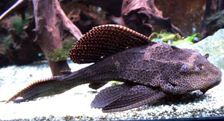Common Pleco
(Hypostomus Plecostomus)
Alternate Names:
Suckermouth Catfish
Plecostomus
Suckermouth
 Common Pleco (Hypostomus Plecostomus) |
Size: Can grow to 12 inches Temp Range: 73°F to 82°F pH Level: 6.5 to 8.0 Lifespan: 8 to 15 years Tank Size: 75 gallons Diet: Pellet, Flake, Vegetable Difficulty: Moderate to Hard |
Geographic History
This very common aquarium fish comes from Brazil, Guyana, Trinidad and Tobago, and Suriname. They are found in calm, slow moving waters of the Amazon River basin.
Enviornment
Common Plecos can get much larger than you might think. They are usually sold as three to four inch juveniles, but can grow to well over one foot long. As they get larger, they produce quite a bit of waste and can put a larger than normal bio-load on your aquarium's filtration system. Be sure you have enough tank and filtration to handle adult sized fish before you buy them.
As with most Plecos, be sure that you provide plenty of hiding spots for these fish. They can be very shy as juveniles and need things to hide under in order to be calm and healthy. Having lots of plants and driftwood in your aquarium works very well.
Compatibility
These armored catfish can be kept with larger fish. They are common tank mates with aggressive Cichlids. You should not keep them with other Plecos because they will become territorial of their feeding and hiding spots. This territory gets bigger as the fish grows.
If you have a large community aquarium, a big Common Pleco is a great fish to have. They are very peaceful to middle and top water swimmers. They will also tolerate bottom dwelling scavengers fairly well, unless they are a Pleco.
Sexing
Males will have large pectoral fins that turn a reddish color as they age. Mature females will be wider in the mid-section when viewed from above.
Behavior
These nocturnal fish will spend most of the day hiding under driftwood or behind a heavily planted area. Larger adults may be less timid and just sit on top of driftwood.
At night they come out and scavenge for bits of food and algae. They will be most often seen, especially as juveniles, as a shadow hanging off the glass or a strange hump on a piece of aquarium decor.
When they are young, they are very handy for keeping algae off of your aquarium glass. As these fish age, they tend to eat less algae. You will have to supplement their diets with sinking algae wafers and raw vegetables to maintain their health.
Sometimes you will see these fish shoot quickly to the surface and then back into hiding. They gulp air to aid in their bouyancy. Be sure that you have a tight hood because they will sometimes misjudge the distance and jump out of the water.
Breeding
Common Plecos are not easy to breed. You will need to set up a very large breeding tank and keep excellent water quality. This means that the breeding tank must have an established filtration system. Provide many hiding spots for them to spawn in. PVC tubes or clay pipes work very well for this purpose. They will need to be five or six inches wide and over a foot long. These pipes should be large enough for the male to fit his entire body inside and have a little room all the way around.
When spawning happens, the female will lay her eggs in the tube. This usually happens at night. After the eggs are laid, remove the female because she will have nothing more to do with the spawning process. The male will tend the eggs by fanning water over them until they hatch. This takes about nine days. The eggs will not hatch if the water temperature is over 72°F.
Having a bare bottom tank will help the fry develop and be healthy. They will attach to the bottom and feed on algae growing there. They will also have an easier time eating crushed flake food and baby brine shrimp that land on the bottom.
You should maintain a very high level of water quality while the fry grow into juveniles. The male parent will deposit a good amount of waste and so will the fry as they grow. Do daily 10% water changes to accomplish this. Be careful not to suck fry out of the aquarium with the old water.
For more information, go to Wikipedia's Common Pleco page.





